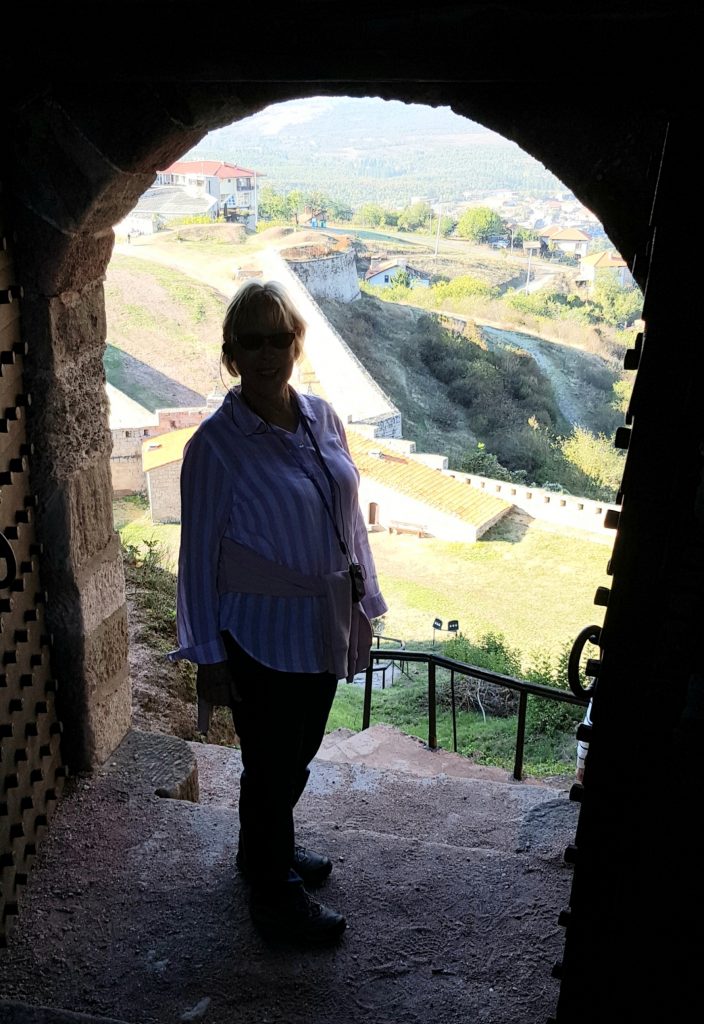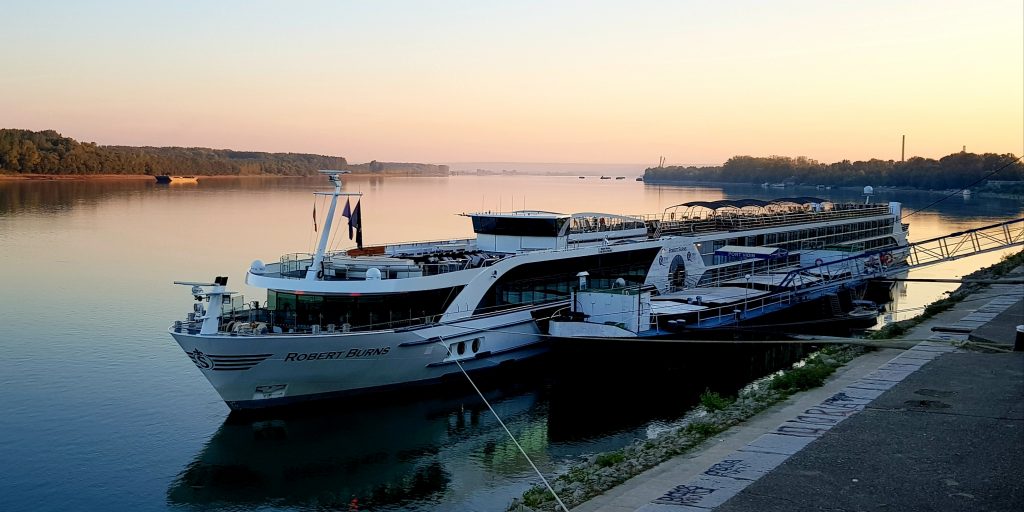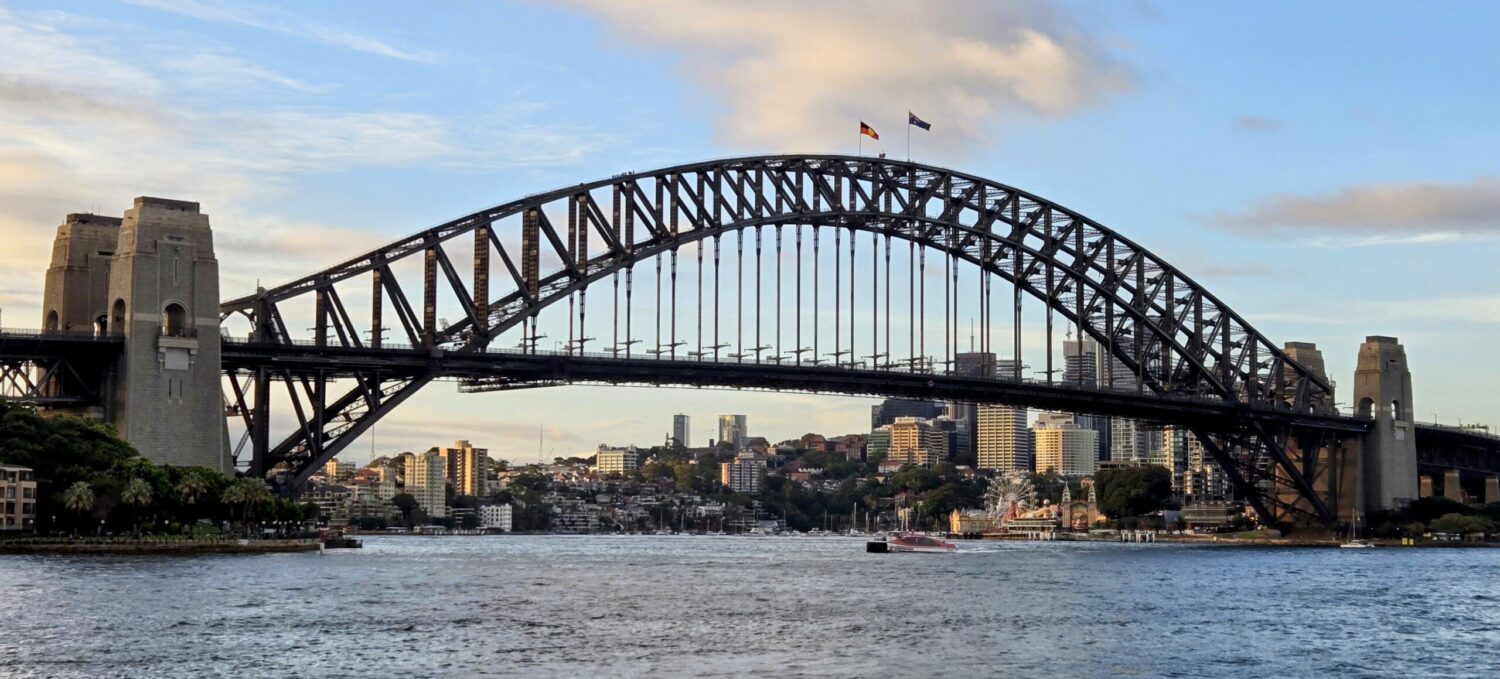We’ve done enough churches – now it’s time for a couple of medieval Bulgarian fortresses! Wednesday is Fort-day!
Mooring at Vidin, we loaded on board our buses. It’s funny how we have become creatures of habit (or are we just getting institutionalised?). We all have our places on the bus! Well, more or less. Four people rush on and bag the front seats. These have the advantage of good forward views but the disadvantage of poor leg-room. We seemed to have settled on the third or fourth rows back – better space to get your feet under the seat in front. We did get the front seats on a couple of occasions. More to displace the two couples who monopolised these seats than for the view! Games, games, games!
Anyway, we had an hour’s ride to the snappily named town of Belogradchik. We are thinking of proposing a name change for our village. Galmptogradchik. It could catch on! En route we had another account of life in Bulgaria (of course).
We heard how Vidin suffered particularly when two factories closed. One tobacco processing plant and one chemical factory. This is an image of part of the abandoned tobacco factory.

About 15,000 people lost their jobs over a period of two years. As a result 35,000 out of a total population of about 65,000 people left Vidin. The hollow shells of these massive industrial concerns are all that remain. A constant reminder on the road out of town. The NW region of this country is affectionately known as the “Abandoned Bulgaria”.
We heard about an interesting characteristic of Bulgarians. Something about not being team players! There is a strict smoking ban in bars, restaurants etc. This is almost totally ignored. By everyone! And they all smoke! Not only that, but Bulgarians’ driving is totally undisciplined. We did see a few examples of risky overtaking manoeuvres. Luckily the roads are relatively quiet although very narrow! Bulgarians also show a serious lack of unity with each other. Strikes are not supported. If the taxi drivers, for example, decline to work, other countrymen (and women) refuse to support them. Ditto for train drivers, teachers or policemen. Not at all like in Greece. There, if one group strikes, it’s all out! The whole country! And it happens frequently at that!
And so to Belogradchik. The fortress consists of three separate fortified yards on three separate levels. It’s built around some spectacular rock formations.

The levels are connected with each other through gates. The view above is looking at the gateway to the second level from the first. Below is the higher level gate looking back down to the entry level.

The fortress walls are over 2 metres thick and reach up to 12 metres in height. The whole place has a total area of more than 10,000 square metres.
The first level walls have a total of 243 arrow slits and emplacements for four cannons. There are also two ammunition stores and two guardhouses (these structures have been much restored).
The second level has a further bunch of arrow slits and two more cannon platforms. But more significant, in a defensive sense, is the steepness of the approach. There are over 200 steps in total, but I’m guessing that the neat metal ladders with handrails which allowed us relatively easy access are not original features.
The third level covers 1800 m2. It was originally established as a Roman defensive position. Approached by more steep and irregular steps. It nestles on the top of the rocky outcrop amongst weird and wonderfully sculpted rock pillars.


… and just to prove we both got to the summit …

Our guide tried to persuade us that each rocky pillar could be viewed as, for example, a monkey or a dog. She pointed out a pair that looked like two lovers kissing. But these have to be viewed from a very specific position. I failed to find the right spot – but Glenda managed. She has a much more vivid imagination than me – obviously!
Anyway. An absolutely amazing place. Fabulous views from the top. Really worth the trip. Indeed it is now being developed as a tourist attraction. We saw at least four tourists there apart from our group.
Back to Vidim where the main landmark is another fortress – of course! It is Fort-day after all.

The Baba Vida fortress was built in the period from the 10th to the 14th century. In the Middle Ages Vidin used to be an important Bulgarian city, a bishop’s seat and the capital of a large province.
The city has had a very colourful history with sieges and despotic leaders. By the early 1290s Serbia expanded towards the vicinity of Vidin. The city failed to repel the invading forces, and had to accept Serbian suzerainty. In practice, Vidin continued to be largely independent and dealt mainly with the rest of Bulgaria. Suzerainty lasted until Serbian king Stefan Milutin’s death, in 1321. I was determined to get that word in a couple of times! (Defined as: “The right of one country to partly control another”. I knew that!) (I also know that that’s a split infinitive!)
Moving on, we elected as a bus-load to walk the mile or so back along the riverbank to our lovely ship rather than take the coach. On the way we did diverge a bit from forts-only day. We passed the ruins of a huge synagogue.

Despite being in ruins, the synagogue is still famous for being the second-largest Jewish temple in Bulgaria. Built in 1894, it fell into disuse after the majority of the local Jews left Bulgaria during and soon after World War 2. Today, the Vidin Synagogue with its four towers stands as a ruin, roofless and forlorn.
During the 1970s a plan to restore the building was hatched. Work began in 1983 and continued until 1989, when the collapse of the communist regime lead to the abandonment of the project – sadly, just as workers had removed the roof. Exposed to the elephants for thirty years the synagogue is now a total ruin.
Moving swiftly on, our boat soon came into view…

… much to everyone’s relief. After all, we had no passports, no bus, no guide and the sun was about to set! OK, and it was dinner time!
Got to go!

How do you remember all these facts and figures?? Or do you use Google a lot? Not sure about doing this trip now- the ship looks amazing, but the sights and scenery not quite as good as Budapest to Amsterdam, which I could do happily again anytime.
Lots of notes taken during bus rides. Some of which make sense later! Photos of information boards help. Cruise information notes also useful. But I do have to check the internet – especially when I’m so far in arrears! And yes, it is very different from the more “Western” end of the river and onwards towards Amsterdam. However it was an extremely interesting and an eye-opening experience.